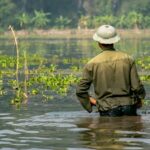Newer and Better Shelters in the Woods
Rossland has so many engaged, enthusiastic, hard-working volunteers for so many community endeavours. Here’s a salute to all of them. This article is dedicated particularly to the ones who have, in years past and also more recently, helped make the Rossland Range a place where people can go to play in the hills free of charge and find warmth and shelter from the winter’s cold.
There has been a lot of activity this year in the area around Strawberry Pass, also known as Nancy Greene Summit. Remember all the alarm about how the formation of the Rossland Range Recreation Site would ruin all the fun, by making it legal to have shelters up there? Because, otherwise, those little structures might have been removed by the Enforcement Branch. Remember how some people insisted that it was stupid and impossible to require them to be rodent-proof, to protect people from rare but potentially deadly hantavirus? How the new shelters wouldn’t be as charming and funky as the old ones because they wouldn’t consist of poles, decomposing plastic tarps, and smoking stoves? Well, of course the new ones aren’t as funky — if funky means makeshift, rodent-infested and dirty — but maybe a lot of funkiness isn’t what we really need the most. Much as we love the old shelters, maybe we love them mainly because we and our friends made them; because they provide shelter from the winter cold, and places to gather together and talk about anything and everything, and melt our cheese sandwiches, or heat up our soup. All of those things are still true of the new places that now replace a few of the funky old ones.
There are now three new shelters to replace their former iterations. Mosquito, pictured above, and built by a crew of volunteers headed by Don Liszt and Laura Mackay, replaces the old Mosquito; the new Lepsoe Basin Shelter, subject to a new name, built by another crew of volunteers headed by Dave Watson and Bob McQueen, replaces Berry Ridge; and the new Viewpoint Shelter, built by a crew of volunteers headed by Rob Richardson, replaces the old View “cabin”. If you want to help with finishing touches on any of these, please contact those project leaders — you can find their contact information on the Friends of the Rossland Range website. Or, for Mosquito, you can visit the FaceBook page dedicated to it.
The Mosquito crew thanks all the volunteers who helped build it, many of whom are named on the FaceBook page, and all those who contributed funds and materials: Interfor, Columbia Glass, Maglio’s, Kootenay Sawyer, Gold Island Cedar, Home Hardware, Hilltech, and Forestry.
You may have read in an earlier article that the old Buffalo Jump shelter is no more. A tree had fallen on it and accomplished most of the demolition already, and a work crew cleaned up the mess that remained. The old Lost shelter, which had become so unsteady on its rotting underpinnings as to be a safety hazard, has also been dismantled and removed.
What’s next?
Friends of the Rossland Range (FORRS), who produced the Management Plan required by the provincial government, are responsible for implementing the plan. Please be warned: the map showing possible locations for new shelters to replace old ones over time is only conceptual and is subject to improvement.
FORRS successfully applied for grants to help fund some of the work that must be done to bring the Recreation Site up to the standards required; this funding is in addition to the base funding provided by the government. Insurance is now provided for volunteers working on the Site under the auspices of FORRS and the Management Plan, but anyone working there with a chainsaw must have passed a chainsaw course to qualify for any insurance coverage.
The old shelters that still remain are much as they were; the new shelters will soon be ready for skiers, snowshoers, hikers, and fat-tire mountain bikers. All we need, sometime in the next month or two, is snow. Lots and lots of lovely snow. To have that, we need a change in weather patterns. Can someone please go out into the Pacific Ocean and move that enormous ridge of high pressure that keeps shunting so much of the precipitation to points north of us?


























